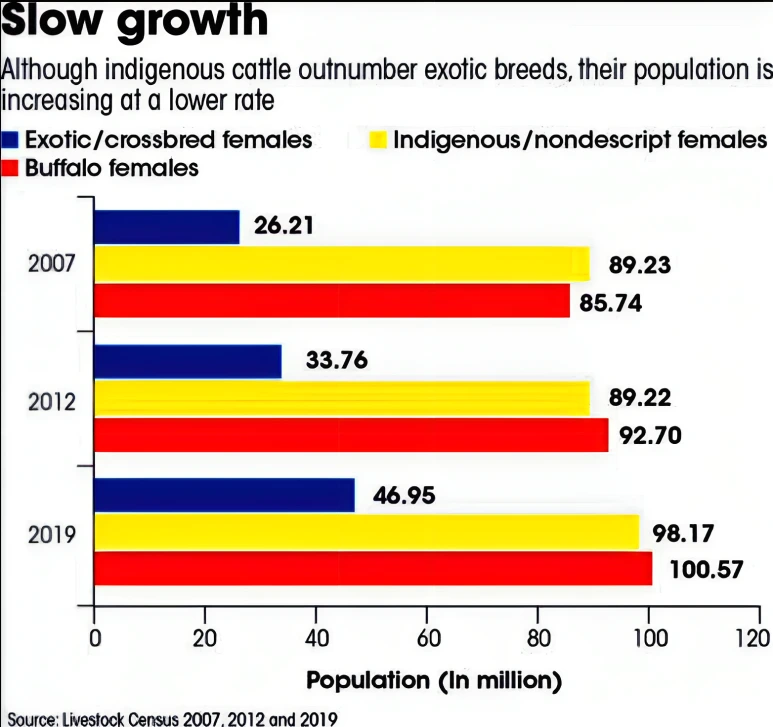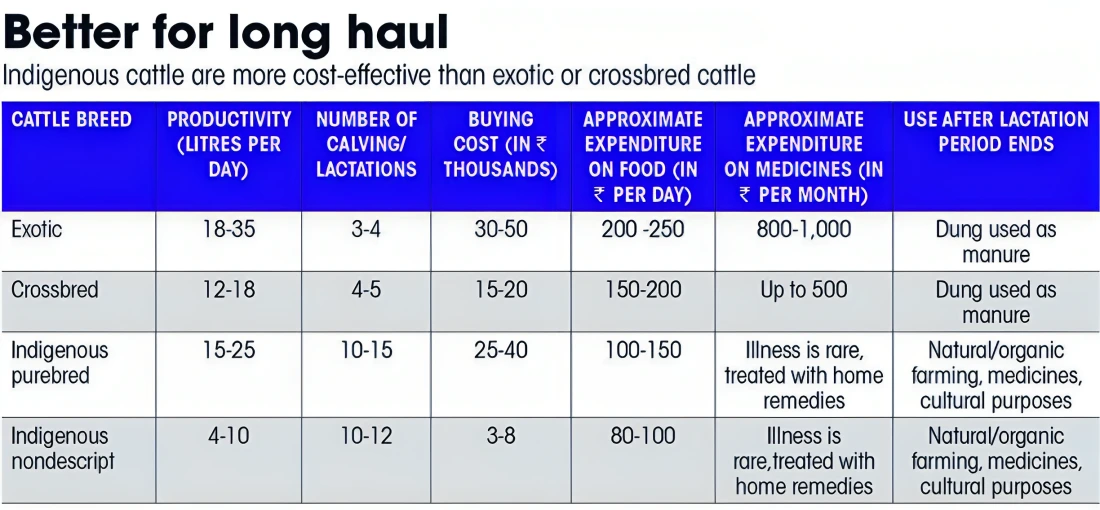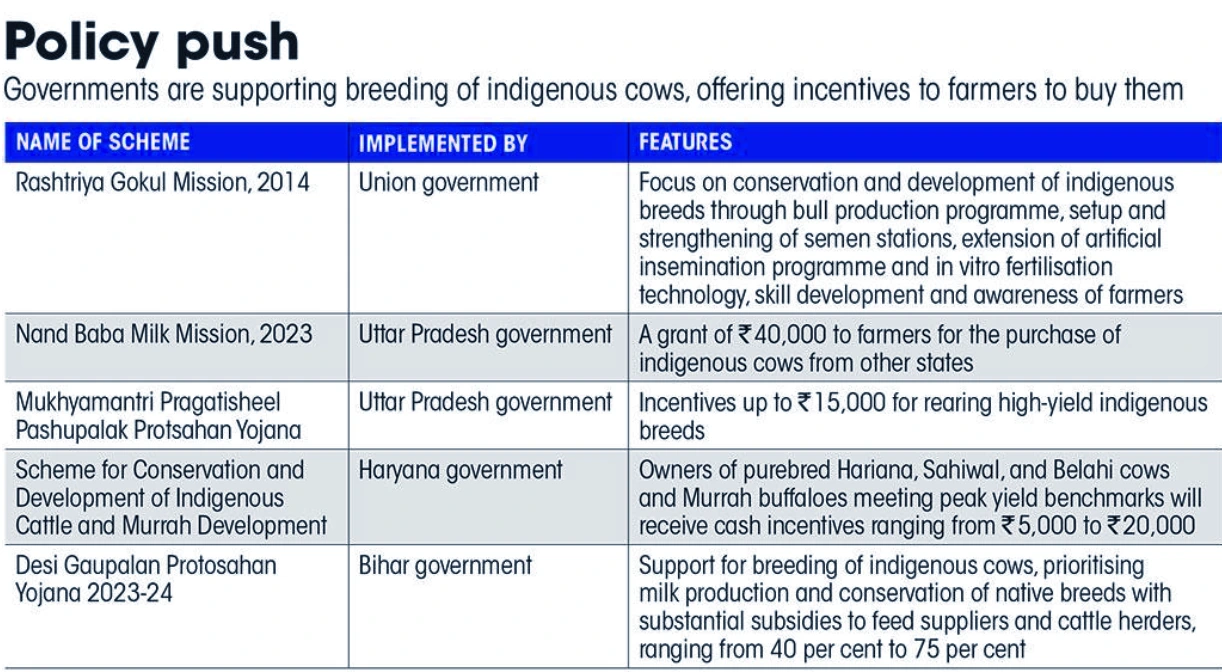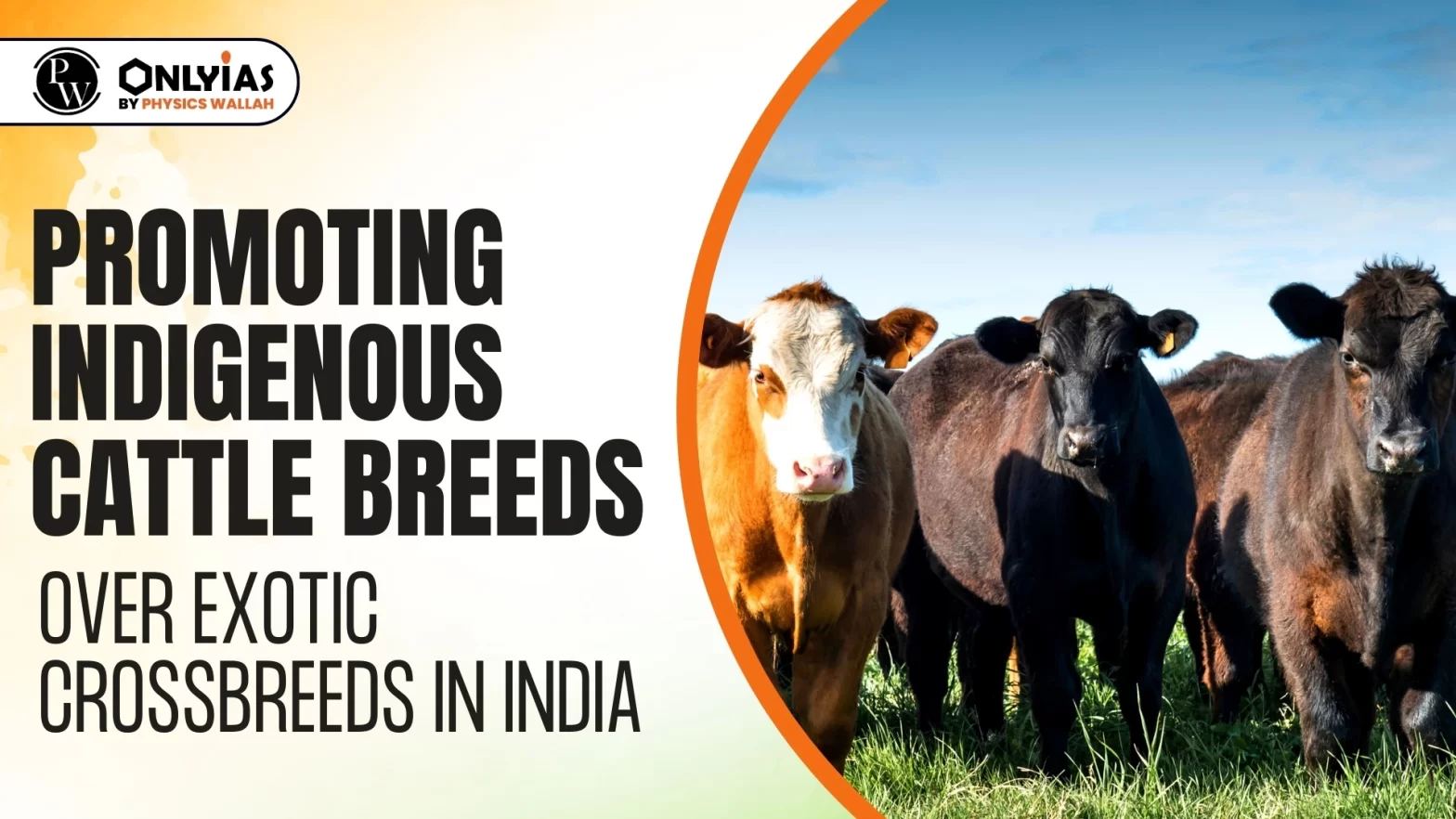Context: This article is based on the news “Homegrown benefit: Why ‘desi’ should be the catchword for India’s dairy sector” which was published in the Down to Earth. The Indian dairy sector needs to shift from exotic and crossbred to indigenous cattle breeds to help the sector stay profitable and sustainable.
| Relevancy for Prelims: Indigenous Cattle Breeds in India, Operation Flood, National Kamdhenu Breeding Centre, and Rashtriya Gokul Mission (RGM).
Relevancy for Mains: Indigenous Cattle Breeds Over Exotic Crossbreeds in India: Reasons, Challenges and Wayforward. |
About Cattle Breeds in India
- India has 50 Indigenous Bovine Breeds (37 Cattle and 13 Buffaloes).
 Milch Breeds: Milch cattle are breeds specifically raised for milk production. Five of these viz. Sahiwal, Gir, Red Sindhi, Tharparkar, and Rathi are known for their milking prowess.
Milch Breeds: Milch cattle are breeds specifically raised for milk production. Five of these viz. Sahiwal, Gir, Red Sindhi, Tharparkar, and Rathi are known for their milking prowess. - Milch and Draught Breeds: Draught cattle are employed for heavy labor purposes, aiding in agricultural activities such as plowing and transportation. Breeds such as Kankrej, Ongole, and Hariana, belong to dual breeds that have both milch and draught qualities (they are good plough animals).
- Since 1970, the Union government has promoted high-yielding breeds, such as Holstein-Friesian, Jersey, Brown Swiss, and Red Dane, under the dairy development program‘ Operation Flood’.
- Specialty of Indian Cows:
- Hump: The hump is an exclusive characteristic of the Indian Desi bulls and cows and facilitates them to carry loads without effort, while the foreign breeds do not have a hump.
- Dewlap: It is a fold of loose skin hanging from the neck of an animal. The Indigenous Cattle have a high heat resistance by virtue of their extensive Dewlaps below the ear, which their foreign counterparts lack.
- Dung: The dung of Indian breeds of cows is used in agriculture, medicine, etc., whereas the dung of foreign breeds is of no use.
About Operation Flood
- Launch: Operation Flood, launched in 1970, has helped dairy farmers direct their own development, placing control of the resources they create in their own hands.
- Significance: India’s milk production surged from a deficit of 110 g per capita in 1973 to a surplus of 433 g per capita in 2022, according to NITI Aayog’s March 2023 white paper.
- National Milk Grid: It links milk producers throughout India with consumers in over 700 towns and cities, reducing seasonal and regional price variations while ensuring that the producer gets fair market prices in a transparent manner on a regular basis.
Must Read: National Milk Day 2023 |
Reasons for Adopting Indigenous Cattle Breed Over Exotic Breeds
- Affordability: Unlike indigenous cattle, the purchase and maintenance of exotic or crossbred cattle is expensive. They need a richer diet, regular baths, fans, and separate enclosures.
- According to research by the Centre for Science of Environment (CSE), Delhi, in a warming world, dairy farmers no longer find the upkeep of exotic breeds cost-effective.
- Adaptability: According to CSE, the exotic breeds, adapted to temperate regions, struggle in heat and humidity. In contrast, indigenous breeds like Gir, Lakhimi, etc. are more adaptable to weather changes as they have been an integral part of Indian agriculture for centuries. Native animals exhibit heat tolerance, disease resistance and ability to thrive in extreme climates.
- For example, milk production of Jersey cows generally reduces in summer because of heat stress whereas indigenous cows rarely get sick and can easily be treated with traditional home remedies.
 Disease Resistance: Global warming is likely to increase the incidence of animal diseases in Crossbred and Exotic animals with a lesser impact on Indigenous Breeds.
Disease Resistance: Global warming is likely to increase the incidence of animal diseases in Crossbred and Exotic animals with a lesser impact on Indigenous Breeds. -
- According to a study published in the Asian Journal of Dairy and Food Research in 2023, indigenous breeds are renowned for their resistance to illnesses including vector-borne trypanosomiasis, and tick-borne babesiosis, and theileriosis.
- Long-Term Gains: Exotic and crossbred cattle were introduced to boost milk production. But unlike indigenous breeds, production drops quickly for crossbreds as they lose the improved function due to cross-breeding.
- According to a study conducted by ICAR-National Dairy Research Institute (NDRI) in 2020, Karan Swiss, a cross of Brown Swiss and Sahiwal developed at the institute, excelled in milk production by 56% in the first generation but this dropped by 24.5% in the second.
About National Bureau of Animal Genetic Resources (NBAGR)
- NBAGR: It is an ICAR institution that has the basic mandate to accord recognition to Indigenous cattle Breeds.
- Conservation of Indigenous Cattle Breeds: The Institute also implements programmes for the development and conservation of a few Indigenous Breeds.
- Conservation Method: Although live animals are not conserved within NBAGR, semen straws and embryos of a few Indigenous Breeds are stored by the Institute in the form of a gene pool.
|
- Emission Reduction: According to the Union Ministry of Environment, Forest and Climate Change’s Third Biennial Update Report (BUR), indigenous dairy cattle account for only 28±5 kg of methane emissions a head per year, whereas a crossbred dairy cattle releases 43±5 kg of methane in a year.
- Inclusive Development: Promoting indigenous breeds supports the livelihoods of small and marginal farmers who may not have the resources to manage exotic breeds effectively.
- Cultural and Social Importance: Indigenous cattle breeds have cultural and religious significance in India as many communities value and prefer the use of indigenous breeds for various agricultural and religious practices.
National Kamdhenu Breeding Centre
- Aim: Development, conservation, and preservation of all the Indigenous Bovine Breeds (37 Cattle and 13 Buffaloes) holistically and scientifically.
- Function: It will meet the imperative need to function as a national repository of germplasm of the fifty Indigenous Breeds of the country. It will also be a source of Certified Genetics in the Country.
- Objectives:
-
- To conserve and preserve Indigenous Bovine breeds.
- To enhance production and productivity.
- To upgrade genetic merit.
- To supply certified elite germplasm.
- To protect threatened breeds from extinction.
|
Must Read: Credit Guarantee Scheme for Livestock Sector
What challenges are associated with Indigenous Cattle Breeds?
- Low Milk Productivity: Indigenous breeds generally have lower milk yields compared to high-yielding exotic breeds leading to low income from milk production.
- Limited Access to Technology: Small and Marginal Farmers may lack access to modern technologies such as improved feeding practices, and advanced healthcare for cattle. This can hinder the improvement of indigenous breeds’ genetic potential and overall productivity.
- Market Demand and Preferences: Shifting consumer preferences and establishing market demand for products from indigenous breeds can be a challenge.
- Declining Population: As per the 20th Livestock Census, the population of total indigenous breed of cattle is declining.
- As per the National Breed-wise Census, populations of some breeds like Tharparkar, Sahiwal, Deoni, Red Sindhi, etc. require attention while breeds like Punganur and Vechur are under extinction.
- Shortage of Germplasm: India faces a shortage quality Germplasm of in indigenous cattle breeds. As of 2019-20, the country has 56 semen stations. But most semen stations cater to the demand for buffalo semen and the germplasm of exotic or crossbred cattle.
- Of the 37 indigenous cattle breeds known for milk production, the semen stations provide germplasm for only nine breeds that are in demand under state breeding policies.

Also Read: Centre To Depute National Level Monitors (NLMs) to Oversee Livestock Schemes
Way Forward
- Improving Product Demand: Increased focus is needed to improve the demand for indigenous cattle milk.
- While demand for desi cow’s milk is rising, dairies prefer crossbred cattle for their milk quantity and high-fat content. Establishing milk co-operatives to promote desi cow milk could improve demand.
- Awareness and Education: Conduct awareness programs and educational campaigns to highlight the benefits of indigenous breeds and their products. This includes workshops, seminars, and extension services to reach out to farmers, veterinarians, and other stakeholders.
- Research and Development: Invest in research and development programs focused on indigenous breeds to improve their productivity, disease resistance, and other desirable traits. This can involve collaborations between research institutions, agricultural universities, and the private sector.
- Livestock Extension Services: Strengthen these services to provide farmers with the necessary knowledge and skills for the management and breeding of indigenous cattle. This includes training programs and on-the-field support.
- For instance, leveraging Krishi Vigyan Kendra (KVK) to reduce the time lag between the generation of technology at the research institution and its application to farmer fields for increasing production, productivity, and net farm income.
- Indigenous Breeds in Dairy Development Programs: Integrate indigenous breeds into national and state-level dairy development programs, ensuring that they receive equal attention and support as exotic breeds.
- Financial Assistance to Small and Marginal Farmers: Provide financial incentives and subsidies to farmers who adopt or maintain indigenous breeds including subsidies on inputs, equipment, and healthcare for indigenous cattle.
- For instance, the Rashtriya Gokul Mission (RGM) is continued under Rashtriya Pashudhan Vikas Yojna for all cattle and buffaloes of India, especially for small and marginal farmers.
Conclusion:
Prioritizing indigenous cattle breeds over exotic crossbreeds in India’s dairy sector is essential for sustainability, economic viability, and preserving cultural significance, requiring concerted efforts in awareness, research, and inclusive development initiatives.
![]() 18 Dec 2023
18 Dec 2023

 Milch Breeds: Milch cattle are breeds specifically raised for milk production. Five of these viz. Sahiwal, Gir, Red Sindhi, Tharparkar, and Rathi are known for their milking prowess.
Milch Breeds: Milch cattle are breeds specifically raised for milk production. Five of these viz. Sahiwal, Gir, Red Sindhi, Tharparkar, and Rathi are known for their milking prowess.  Disease Resistance: Global warming is likely to increase the incidence of animal diseases in Crossbred and Exotic animals with a lesser impact on Indigenous Breeds.
Disease Resistance: Global warming is likely to increase the incidence of animal diseases in Crossbred and Exotic animals with a lesser impact on Indigenous Breeds. 
